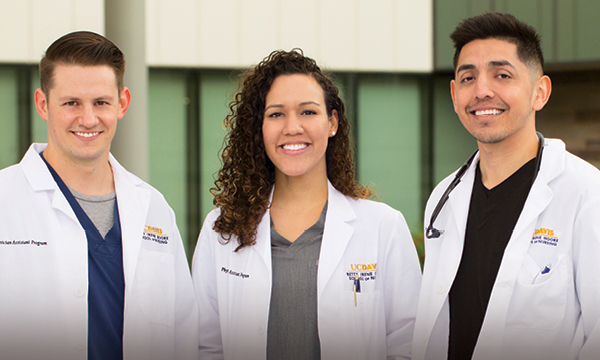
Training physician assistants in a nursing school?
Interprofessional model breaks molds, breeds success
In the years following World War II, the nation faced a shortage of primary care physicians. Health care experts turned to corpsmen, who received medical training during their service, and registered nurses. But in the mid-1960s, two new professions emerged: family nurse practitioners (FNPs) and physician assistants (P.A.s). In the early ’70s, the UC Davis School of Medicine continued that creativity and launched a certificate program for both disciplines.
“From the beginning, we thought it would be ideal for P.A.s and FNPs to learn together,” says Alfred Sadler, a pioneer of the P.A. profession. “You had some very innovative doctors and nurses who were doing that here at UC Davis.”
More than 45 years later, that creative tradition of educating P.A.s and FNPs together continues in the Betty Irene Moore School of Nursing at UC Davis. But what was once a community-based certificate program, now requires students to be in class and in person to earn a master’s degree.
“Since we had a model of educating P.A.s and FNPs together for decades, why not at a nursing school?” says Virginia Hass, who earned both P.A. and FNP certificates from UC Davis, then became a faculty member for the programs in both schools. “Some argue we are more alike than not. Yet, we should capitalize on how to combine our unique strengths and identities to make the health care system stronger.”
Still, the school setting presents challenges, whether a lack of professional identity for the P.A. students or not enough P.A. faculty members serving as professional role models. Program Director Jeffrey Pearl says the opportunities outweigh the difficulties.
“Educators everywhere want to figure out the interprofessional piece of the puzzle. By design, our students are working together and learning from each other from day one,” Pearl says. “Plus, we benefit from incredible simulation facilities. We capitalize on what we have and continue to refine.”
The two professions enjoy signif-icant areas of overlap, yet are still distinct in their education, certification and licensure. Recent standards released from the Accreditation Review Commission on Education for the Physician Assistant includes new requirements — focused on quality and leadership — that UC Davis students learn from the beginning.
“Our programs have always been on the cutting edge in terms of the professions since their infancy,” Hass says. “As the School of Nursing continues to innovate and adapt to meet the needs of communities, I imagine these programs will continue to evolve as well.”
Once again, as the nation faces shortages of primary care providers, graduates of this program will continue to reshape the landscape of health care and serve where needed.

